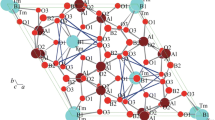Abstract
Monoisotopic \(^{53}\hbox {Cr}^{3+}\) impurity ions in scandium orthosilicate single crystal (\(\hbox {Sc}_2\hbox {SiO}_5\)) are studied by the method of electron paramagnetic resonance in the X-band frequencies. The directions of the main principal magnetic axes and the parameters of the effective spin Hamiltonian that describe the magnetic characteristics of the impurity centers of chromium, which replaces scandium in two structurally nonequivalent positions, are determined. It is shown that the orientation dependencies of the EPR spectra are well described by the second-order spin Hamiltonian corresponding to the orthorhombic symmetry of the local crystal field acting on the impurity ion. It was assumed that the g-tensor and the A-tensor determining the Zeeman energy of electronic levels in a magnetic field and the hyperfine interaction of electron and nuclear spins are isotropic, and the entire anisotropy of the EPR spectra is due to the anisotropy of the D-tensor, which describes the fine structure of electronic levels in a crystalline electric field. A strong dependence of the probability of “forbidden” transitions between hyperfine sublevels of electronic levels on the orientation of an external magnetic field is established. Moreover, for some orientations, the probability of “forbidden” transitions exceeds the probability of “allowed” transitions.







Similar content being viewed by others
References
S. Kück, Appl. Phys. B 72, 515 (2001). https://doi.org/10.1007/s003400100540
R. Moncorge, Opt. Materials 63, 105 (2017). https://doi.org/10.1016/j.optmat.2016.05.060
T. Maiman, Nature 6, 493 (1960). https://doi.org/10.1038/187493a0
C. Deka, B.H.T. Chai, Y. Shimony, X.X. Zhang, E. Munin, M. Bass, Appl. Phys. Lett 61, 2141 (1992). https://doi.org/10.1063/1.108300
J. Koetke, S. Kück, K. Petermann, G. Huber, G. Cerullo, M. Danailov, V. Magni, L. Qian, O. Svelto, Opt. Commun. 101, 195 (1993). https://doi.org/10.1016/0030-4018(93)90366-D
V. Vazhenin, A. Potapov, G. Shakurov, A. Fokin, M.Y. Artyomov, V.A. Isaev, Phys. Solid State 60, 2039 (2018). https://doi.org/10.1134/S106378341810030X
V. Tarasov, I. Yatsyk, R. Likerov, A. Shestakov, R. Eremina, Y. Zavartsev, S. Kutovoi, Opt. Materials 105, 109913 (2020). https://doi.org/10.1016/j.optmat.2020.109913
M. Alba, P. Chain, T. Gonzalez-Carrascosa, J. Am. Ceram. Soc. 92, 487 (2009). https://doi.org/10.1111/j.1551-2916.2008.02877.x
Y. Sun, T. Böttger, C. Thiel, R.L. Cone, Phys. Rev. B 77, 085124 (2008). https://doi.org/10.1103/PhysRevB.77.085124
S. Stoll, A. Schweiger, J. Mag. Reson. 178, 42 (2006). https://doi.org/10.1016/j.jmr.2005.08.013
A. Abragam, B. Bleaney, Electron Paramagnetic Resonance of Transition Ions (Oxford University Press, Oxford, 1970)
V. Tarasov, G. Shakurov, Appl. Magn. Reson. 2, 571 (1991). https://doi.org/10.1007/BF03166064
Acknowledgements
The authors are grateful to V. A. Shustov for the X-ray studies of the samples. This research was supported by the Russian Science Foundation, project No. 16-12-00041.
Author information
Authors and Affiliations
Corresponding author
Ethics declarations
Conflicts of interest
The authors declare that they have no conflict of interest.
Additional information
Publisher's Note
Springer Nature remains neutral with regard to jurisdictional claims in published maps and institutional affiliations.
Rights and permissions
About this article
Cite this article
Tarasov, V.F., Eremina, R.M., Konov, K.B. et al. EPR Spectroscopy of \(^{53}\hbox {Cr}^{3+}\) Monoisotopic Impurity Ions in a Single Crystal of Scandium Orthosilicate \(\hbox {Sc}_{2}\hbox {SiO}_{5}\). Appl Magn Reson 52, 5–14 (2021). https://doi.org/10.1007/s00723-020-01225-x
Received:
Revised:
Published:
Issue Date:
DOI: https://doi.org/10.1007/s00723-020-01225-x



